

087613eo.pdf. About Taxonomies & Controlled Vocabularies. Page Contents: Controlled Vocabularies A controlled vocabulary, also called an authority file, is an authoritative list of terms to be used in indexing (human or automated).
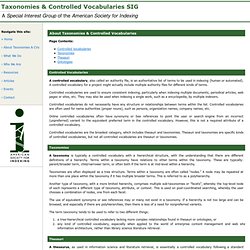
A controlled vocabulary for a project might actually include multiple authority files for different kinds of terms. Controlled vocabularies are used to ensure consistent indexing, particularly when indexing multiple documents, periodical articles, web pages or sites, etc. They may also be used when indexing a single work, such as a encyclopedia, by multiple indexers. Controlled vocabularies do not necessarily have any structure or relationships between terms within the list. Online controlled vocabularies often have synonyms or See references to point the user or search engine from an incorrect (unpreferred) variant to the equivalent preferred term in the controlled vocabulary.
Controlled vocabularies are the broadest category, which includes thesauri and taxonomies. Taxonomies Thesauri Ontologies. DHLUNBISThesaurus. Cette version électronique constitue la quatrième édition du Thésaurus UNBIS, la première incluant toutes les langues officielles des Nations Unies : anglais, arabe, chinois, espagnol, français et russe.
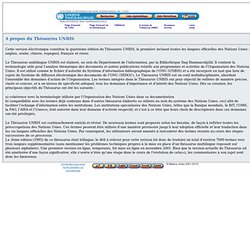
Le Thésaurus multilingue UNBIS est élaboré, au sein du Département de l’information, par la Bibliothèque Dag Hammarskjöld. Il contient la terminologie utile pour l’analyse thématique des documents et autres publications relatifs aux programmes et activités de l’Organisation des Nations Unies. Il est utilisé comme le fichier d’autorité du Système d’information bibliographique de l’ONU (UNBIS) et a été incorporé en tant que liste de sujets du Système de diffusion électronique des documents de l’ONU (SEDOC).
Le Thésaurus UNBIS est un outil multidisciplinaire, abordant l'ensemble des domaines d’action de l’Organisation. SearchFAST. Welcome to the new searchFAST user interface.
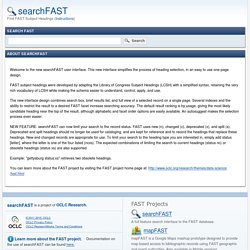
This new interface simplifies the process of heading selection, in an easy to use one-page design. FAST subject headings were developed by adapting the Library of Congress Subject Headings (LCSH) with a simplified syntax, retaining the very rich vocabulary of LCSH while making the schema easier to understand, control, apply, and use. The new interface design combines search box, brief results list, and full view of a selected record on a single page. Several indexes and the ability to restrict the result to a desired FAST facet increase searching accuracy. The default result ranking is by usage, giving the most likely candidate heading near the top of the result, although alphabetic and facet order options are easily available. NEW FEATURE: searchFAST can now limit your search to the record status. Example: "gettysburg status:xs" retrieves two obsolete headings. Thesauri and Controlled Vocabularies (Librarians and Archivists, Library of Congress)
Subject cataloging depends on lists of controlled subject access vocabulary and thesauri.
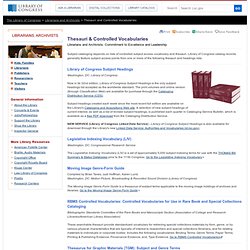
Library of Congress catalog records generally feature subject access points from one or more of the following thesauri and headings lists: Library of Congress Subject Headings Washington, DC: Library of Congress Now in its 32nd edition, Library of Congress Subject Headings is the only subject headings list accepted as the worldwide standard. LCSH Browser. This database contains about 6.2 million Library of Congress Subject Headings, set up for browsing by the authority headings themselves but also by phrases and even words contained in the headings.
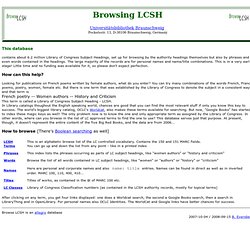
The large majority of the records are for personal names and name/title combinations. This is in a very early stage! Little time and no funding was available for it, so please don't expect perfection. How can this help? Looking for publications on French poems written by female authors, what do you enter? How to browse [There's Boolean searching as well] After clicking on any term, you get four links displayed: one does a Worldcat search, the second a Google Books search, then a search in LibraryThing and in OpenLibrary. DHLUNBISThesaurus. An Experimental Classification Service. Enter an ISBN, OCLC#, UPC, or ISSN Standard Number: An ISBN is a unique number assigned to an item by its publisher.
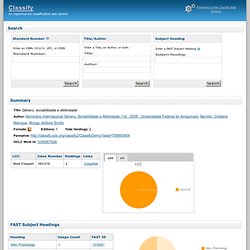
Each ISBN is a 10 or 13 digit number. Thirteen-digit ISBNs must begin with either 978 or 979. Enter ISBNs with our without hyphens. For example; OCLC assigns a unique number to each bibliographic record input into WorldCat. The Universal Product Code (UPC) is a barcode symbol that is used to track trade items in stores (e.g., audio and video products). The first digit is the Number System Character (NSC) which appears on the left side of the symbol outside of the bars. Enter all digits found on the item (e.g., 008817006925). An ISSN is a standardized international code which allows the identification of a serial publication.
EuroVoc. Examples of Controlled Vocabularies, Keyword, Hierarchical Classification, Thesauri, Taxonomy and Subject Heading systems used in databases (Controlled Vocabulary, Thesaurus, facet classification, Hierarchy) Example Controlled Vocabularies and Thesauri available online Some of the oldest and best known controlled vocabularies are those used by the United States Library of Congress.
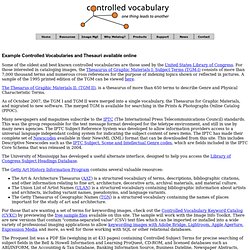
For those interested in cataloging images, the Thesaurus of Graphic Materials I: Subject Terms (TGM-I) consists of more than 7,000 thousand terms and numerous cross references for the purpose of indexing topics shown or reflected in pictures. A sample of the 1995 printed edition of the TGM can be viewed here. The Thesarus of Graphic Materials II: (TGM II), is a thesaurus of more than 650 terms to describe Genre and Physical Characteristic Terms. Union List of Artist Names (Research at the Getty) Search Tips For the Find Name field, you may use AND and OR [e.g., 1) eldon garnet, 2) garnet OR carnet, 3) garnet OR carnet OR karnette, 4) eldon AND carnet, 5) eldon AND (garnet OR carnet), 6) (eldon OR elton) AND (garnet OR carnet)].

Boolean operators must be in all caps (AND and OR). Wildcard is the asterisk (*); right truncation only. To find an exact match rather than a key word, use quotes [e.g., "carlos"]. Thesaurus of Geographic Names. Art & Architecture Thesaurus. Search Tips For the Find Term or Note field, you may use AND and OR (all in upper case) [e.g., 1) windsor chairs, 2) chairs OR rockers, 3) chairs OR rockers OR armchairs, 4) bow-back AND windsor, 5) windsor AND (rockers OR chairs), 6) (windsor OR boston) AND (rockers OR chairs)].
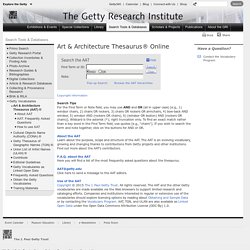
Wildcard is the asterisk (*); right truncation only. To find an exact match rather than a key word in the Find Term field, use quotes [e.g., "chairs"]. If you wish to search the term and note together, click on the buttons for AND or OR. About the AATLearn about the purpose, scope and structure of the AAT. The AAT is an evolving vocabulary, growing and changing thanks to contributions from Getty projects and other institutions. F.A.Q. about the AATHere you will find a list of the most frequently asked questions about the thesaurus. AAT@getty.eduClick here to send a message to the AAT editors.
Use of the AATCopyright © 2015 The J.